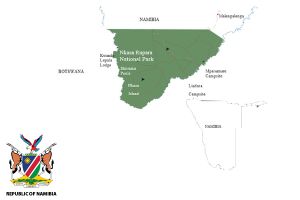Nkasa Rupara National Park Mamili
National Parks "Nkasa Rupara National Park (formerly known as Mamili )"
Nkasa Rupara National Park formally known as Mamili National Park was officially proclaimed on 1 March 1990, just days before Namibia gained Independence. This is the largest wetland area with conservation status in Namibia, and is a haven for wetland species. When the flood waters from the Kwando R
Read more +
Nkasa Rupara National Park formally known as Mamili National Park was officially proclaimed on 1 March 1990, just days before Namibia gained Independence. This is the largest wetland area with conservation status in Namibia, and is a haven for wetland species. When the flood waters from the Kwando River are high, the park becomes like a mini Okavango Delta.
There are about 1 000 buffaloes in Nkasa Rupara, the largest concentration in the country. It is an important corridor for elephants moving from Botswana to Angola and Zambia and is also considered as a core breeding area for wildlife that can disperse into neighbouring conservancies.
Park size: 320 km²
Natural features: Most of the park consists of channels of reed beds, lagoons and termitaria islands. The Kwando River forms the western boundary and the Linyanti River the south-eastern border of the park.
Vegetation: Tree and Shrub Savannah Biome. Zambezi Floodplain. Reeds, sedges, and papyrus, wild date palms (Phoenix reclinata). Tall trees such as jackal-berry (Diospyros mespiliformis) and mangosteen (Garcinia livingstonei) along the water edges and on the termitaria.
Wildlife: Hippo, Crocodile, Elephant, Buffalo, Lion, Leopard, Hyaena, African wild dog, Roan Antelope, Common impala, Red Lechwe, Reedbuck, Sitatunga, Kudu, Warthog, Spotted-necked otter, rock and water monitor lizard. 430 species of birds recorded, include breeding pairs of rare Wattled Cranes; Slaty Egret, Stanley’s Bustard, Rosy-throated Longclaw, Dickinson’s Kestrel, Allen’s Gallinule,Lesser Jacana, Black-winged and Red-winged Pratincoles, Long-toed, Lapwing, Luapula Cisticola, Coppery-tailed Coucal and Black Coucal.
Tourism: Nkasa Rupara provides the ultimate wilderness experience. 4x4 vehicle equipped with recovery equipment is required. There are no facilities, so visitors must be self-sufficient. Park fees must be either pre-paid at MET offices in Katima Mulilo or Windhoek or upon arrival. For Accommodation and Camping use Zone 27 Hide
There are about 1 000 buffaloes in Nkasa Rupara, the largest concentration in the country. It is an important corridor for elephants moving from Botswana to Angola and Zambia and is also considered as a core breeding area for wildlife that can disperse into neighbouring conservancies.
Park size: 320 km²
Natural features: Most of the park consists of channels of reed beds, lagoons and termitaria islands. The Kwando River forms the western boundary and the Linyanti River the south-eastern border of the park.
Vegetation: Tree and Shrub Savannah Biome. Zambezi Floodplain. Reeds, sedges, and papyrus, wild date palms (Phoenix reclinata). Tall trees such as jackal-berry (Diospyros mespiliformis) and mangosteen (Garcinia livingstonei) along the water edges and on the termitaria.
Wildlife: Hippo, Crocodile, Elephant, Buffalo, Lion, Leopard, Hyaena, African wild dog, Roan Antelope, Common impala, Red Lechwe, Reedbuck, Sitatunga, Kudu, Warthog, Spotted-necked otter, rock and water monitor lizard. 430 species of birds recorded, include breeding pairs of rare Wattled Cranes; Slaty Egret, Stanley’s Bustard, Rosy-throated Longclaw, Dickinson’s Kestrel, Allen’s Gallinule,Lesser Jacana, Black-winged and Red-winged Pratincoles, Long-toed, Lapwing, Luapula Cisticola, Coppery-tailed Coucal and Black Coucal.
Tourism: Nkasa Rupara provides the ultimate wilderness experience. 4x4 vehicle equipped with recovery equipment is required. There are no facilities, so visitors must be self-sufficient. Park fees must be either pre-paid at MET offices in Katima Mulilo or Windhoek or upon arrival. For Accommodation and Camping use Zone 27 Hide
Booking
Booking Enquiry
for firm date requests
Trade Enquiry
for STO Rates
SADC Resident Rates
SADC passport holders

